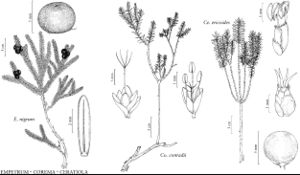Difference between revisions of "Ceratiola"
Fl. Bor.-Amer. 2: 221. 1803 ,.
imported>Volume Importer |
imported>Volume Importer |
||
| Line 47: | Line 47: | ||
|publication year= | |publication year= | ||
|special status= | |special status= | ||
| − | |source xml=https:// | + | |source xml=https://bitbucket.org/aafc-mbb/fna-data-curation/src/2e0870ddd59836b60bcf96646a41e87ea5a5943a/coarse_grained_fna_xml/V8/V8_957.xml |
|subfamily=Ericaceae subfam. Ericoideae | |subfamily=Ericaceae subfam. Ericoideae | ||
|genus=Ceratiola | |genus=Ceratiola | ||
Latest revision as of 22:47, 5 November 2020
Subshrubs or shrubs, (dioecious, aromatic). Stems erect, (diffusely branched; branches numerous, ascending); old twigs rough with persistent leaf bases, young twigs tomentose. Leaves persistent, whorled; petiole present; blade coriaceous, margins entire. Inflorescences axillary, fascicles, 2–3-flowered; perulae absent. Flowers unisexual (dioecious), radially symmetric; sepals 2(–3), distinct; petals 2(–3), distinct, corolla persistent, ovoid; stamens 2, exserted; anthers without awns, longitudinally dehiscent; ovary 2-locular; style exserted, straight; stigma linear. Fruits drupaceous, globose, dry. Seeds (pyrenes) 2, planoconvex, not winged, not tailed; testa ± smooth. x = 13.
Distribution
se United States.
Discussion
Species 1: se United States.
Ceratiola was treated formerly within Empetraceae, along with Corema and Empetrum. Phylogenetic studies based on morphological and molecular data (A. A. Anderberg 1994c; K. A. Kron et al. 2002; Li J. H. et al. 2002) indicate that the Empetrum and Ceratiola + Corema lineages form a monophyletic group nested consistently within Ericaceae. The phylogenetic relationship between Ceratiola and the North American species of Corema is not resolved fully, and molecular data suggest possible ancestral hybridization events between Ceratiola ericoides and Corema conradii (Li et al.). Ceratiola differs from Corema by having two to three flowers in leaf axils, petals present, and two seeds per fruit. Empetrum is distinguished readily from Ceratiola by having solitary flowers in leaf axils and six to nine carpels and a corresponding number of seeds per fruit.
Species 1
